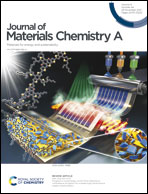Cu–ion induced self-polymerization of Cu phthalocyanine to prepare low-cost organic cathode materials for Li-ion batteries with ultra-high voltage and ultra-fast rate capability†
Abstract
High cost, complex synthesis routes and low yield are pressing challenges hindering the practical application of organic battery materials. Herein, copper(II) phthalocyanine (CuPc), one of the most frequently used blue pigments, is directly used as a cathode material in lithium ion batteries. CuPc has a well-defined discharge voltage plateau that is higher than 3.6 V. The discharge capacity of CuPc at 1C of 93.1 mA h g−1 is close to the theoretical discharge capacity. Even at a high rate of 50C, the material remains close to its discharge capacity of 1C, without discernible polarization of the voltage. In addition, CuPc maintains 67% of its initial capacity after 1000 cycles at 20C with nearly 100% coulombic efficiency. Additionally, at high charging voltages, the benzene rings between the CuPc molecules undergo self-polymerization reactions that are catalysed by the copper(II) ions in CuPc.



 Please wait while we load your content...
Please wait while we load your content...